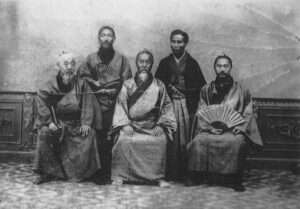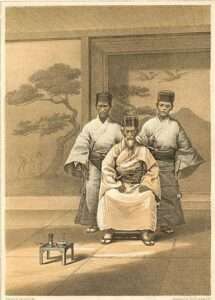Hierarchy in the Ryukyu Kingdom – A Complex Caste System.

The Ryukyu Kingdom, a historical gem situated in the captivating landscapes of what is now Okinawa, Japan, was characterized by a meticulously structured social hierarchy known as the Ryukyuan Caste System. This intricate system, in place for centuries, assigned specific roles, privileges, and distinctions to different classes of individuals, each contributing to the functioning of the kingdom. At the top of this elaborate hierarchy were the “Yukatchu”, a revered class that played a central role in the kingdom’s governance and cultural development.
About the image: Envoys sent by the Ryukyu Kingdom to offer its congratulations for the success of the Meiji Restoration; front row: (c) Prince Ie, (l) Giwan Chōho, (r) Pechin Kyan Chōfu (father of Kyan Chōtoku); back row (l) Yamasato Pechin, (r) an official from the Ministry of Foreign Affairs.
Origins of the Ryukyu Caste System.
The Ryukyu caste system, a complex social hierarchy in the Ryukyu Kingdom, had its origins in the 14th to 15th centuries when the Ryukyu Kingdom established itself as a powerful trading state. Influenced by Chinese Confucian ideals and Japanese hierarchical systems, this social structure aimed to maintain social order, ensure stability, and organize society. The Ryukyu rulers adapted Chinese concepts to create a unique caste system that reflected their own social and political needs.
Significance and Structure of the Ryukyu Caste System.
The Ryukyu caste system held profound significance in the social fabric of the Ryukyu Kingdom. Its framework, composed of ruling, commoner, and servant classes, played a critical role in defining the roles, responsibilities, and privileges of individuals. This hierarchy ensured social order, with the ruling class, known as the “Yukatchu,” exerting political influence and maintaining ties with the Chinese Imperial Court.
At the top of this system were the aristocrats, known as the Shō 2, responsible for governing the kingdom. Below them were warriors, such as the Samurais or Nochi, who protected it. Commoners, represented by the Chen class 3, engaged in various trades and agriculture, while at the bottom, the Eta 4, or outcasts, performed menial tasks.
Enduring Legacy, Transformation, and Reflection.
The impact of the Ryukyu caste system continued even after Japan annexed the Ryukyu Kingdom in the late 19th century. The traditional social hierarchy gradually lost significance as Japan modernized and integrated Okinawa into its administrative structure. Today, while remnants of the caste system’s influence can still be observed in specific cultural practices and perceptions, Okinawan society has evolved into a more egalitarian structure. The Ryukyu caste system is a thing of the past, but its legacy remains embedded in Okinawan society and culture, evident in traditional practices, social relationships, and contemporary perceptions of social status. As Okinawa has undergone significant social changes, it now allows for more social mobility and greater equality.
Understanding the Ryukyuan Caste System.
The Ryukyuan Caste System was a multifaceted framework that categorized the population into various social classes, each with distinct functions and responsibilities. At its core, this system served to maintain order, distribute resources, and ensure the smooth operation of the Ryukyu Kingdom.
Key Elements of the Ryukyuan Caste System.

The Ryukyuan Caste System was divided into multiple classes, each with its distinct privileges, responsibilities, and restrictions:
- Royalty – The Shō Family: The pinnacle of the caste system was occupied by the Shō family, with titles like “Ōji” denoting a prince and “Aji” or “Anji” signifying descendants of the royal lineage.
- Yukatchu – The Scholar-Officials: The Yukatchu were known for their commitment to scholarly pursuits. They dominated government positions and included titles like “Ueekata” or “Oyakata” representing lords and various levels of “Pechin,” such as “Pekumi,” “Satunushi Pechin,” and “Chikudun Pechin.” There were also “Satunushi” and “Chikudun,” referred to as upper and lower pages. This class was entrusted with enforcing the law and ensuring the military defense of the Ryukyu Kingdom.
- Heimin – The Commoners: At the base of the social pyramid were the Commoners, known as “Heimin.” These individuals did not hold any official titles or privileges within the Ryukyuan Caste System.
The Legacy of Yukatchu: Guardians of Culture and Martial Arts.
The Yukatchu played a pivotal role in preserving and advancing Ryukyuan culture. Their commitment to classical Chinese studies ensured the perpetuation of traditional knowledge and customs. Moreover, they were the primary custodians of the Ryukyuan fighting style known as “Ti” or “Te,” which would later evolve into the globally recognized discipline of Karate.
Challenges and Transformation of the Ryukyuan Caste System.
The Ryukyuan Caste System faced various challenges and underwent significant transformations over the centuries. These challenges included the confiscation of weapons, both during the reign of King Shō Shin and after the 1609 invasion by the Satsuma Domain. The Meiji Period brought substantial changes, as Japan formally annexed the Ryukyu Kingdom. With the advent of the Meiji government, the Yukatchu class grappled with issues of assimilation and cultural preservation.
Ryukyuan Caste System.
The historical records regarding the specific classes and their hierarchical distinctions in the caste system of the Ryukyu Kingdom are not as well documented. Therefore, it is not possible to provide a detailed list of all the intermediate classes between the broad categories.
1) Royalty
- Ōji (王子, Ōji): Prince
- Aji or Anji (按司, Aji): Descendant of Prince, Cadet Branch of Royal House
2a) Upper Class (Yukatchu)
- Yukatchu (良人, Yukatchu) – scholar-officials
- Ueekata or Oyakata (親方, Ueekata): Lord
- Pekumi (親雲上, Peekumii): Upper Pechin
- Shō-sanpon (Senior Third Rank)
- Ju-sanpon (Junior Third Rank)
- Shō-yonpon (Senior Fourth Rank)
- Ju-yonpon (Junior Fourth Rank)
2b) Middle Class (Yukatchu)
- Satunushi Pechin (里之子親雲上, Satunushi Peechin): Middle Pechin
- Shō-gohon (Senior Fifth Rank)
- Ju-gohon (Junior Fifth Rank)
- Shō-roppon (Senior Sixth Rank)
- Ju-roppon (Junior Sixth Rank)
- Shō-shichihon (Senior Seventh Rank)
- Ju-shichihon (Junior Seventh Rank)
2c) Lower Class (Yukatchu)
- Chikudun Pechin (筑登之親雲上, Chikudun Peechin): Lower Pechin
- Satunushi
- Shō-happon (Senior Eighth Rank)
- Ju-happon (Junior Eighth Rank)
- Chikudun
- Shō-kyūhon (Senior Ninth Rank)
- Ju-kyūhon (Junior Ninth Rank)
- Shii (子): Could refer to a specific occupation, role, or title.
- Niya (仁屋): Could refer to a specific occupation, role, or title.
3) Heimin (Commoners)
- Hyakushō (百姓): Farmer, fisherman, craftsman.
Chikudun Pechin and Oyakata Classes: Examples from History
Within the Ryukyuan Caste System, several classes played vital roles in governing and protecting the kingdom, as well as preserving its culture. Here are some notable figures and their respective roles, offering insights into both their contributions and the comprehensive framework of the caste system.
Chikudun Pechin Class: Guardians of Tradition.
Sakugawa Kanga (1786-1867): A prominent figure of the Chikudun Pechin class, Sakugawa Kanga was known for his role in preserving and promoting traditional Ryukyuan martial arts.
Chatan Yara (1740-1812): Another member of the Chikudun Pechin class, Chatan Yara, contributed to the cultural heritage of Okinawa.
Tawata Shinboku (1814-1884): Tawata Shinboku, a Chikudun Pechin, was among those responsible for maintaining the rich heritage of the Ryukyuan people.
Chinen Masanra (1842-1925): Chinen Masanra, belonging to the Chikudun Pechin class, played a crucial role in the preservation of Ryukyuan traditions and knowledge.
Oyakata Class: Close to the King.
Soeishi Ryotoku (1772-1825): Soeishi Ryotoku held the distinguished title of Oyakata and served as the king’s secretary, exemplifying the significance of this class in the kingdom’s administration.
Hamahiga Oyakata (1847 – unknown): Another notable figure in the Oyakata class, Hamahiga Oyakata, contributed to the kingdom’s governance and administration.
Pechin Class: Protectors and Officials.
Matsumura Sokon (1809-1899): A member of the Pechin class, Matsumura Sokon served as a bodyguard to the king, emphasizing the class’s role in safeguarding the kingdom.
Sueyoshi Anyu (unknown): Sueyoshi Anyu, belonging to the Pechin class, contributed to the governance and well-being of the Ryukyu Kingdom.
Higa Kanematsu (1790-1870): Higa Kanematsu, a member of the Pechin class, played a role in the administration of the kingdom, further highlighting the class’s significance.
Shizoku Class: Aristocratic Governance.
Kyan Chofu (unknown): Kyan Chofu was part of the Shizoku class, which was closely associated with the governance of the kingdom.
Concluding Thought.
Within the complex structure of the Ryukyuan Caste System, we discover a rich history, culture, and human resilience. This complex social hierarchy, with its diverse classes and intricate roles, has left a lasting legacy on the vibrant landscape of Okinawa. While it remains a historical relic, the Ryukyuan Caste System serves as a symbol of adaptability and the unyielding strength of its people.
Lessons from this system extend beyond its past and apply to the broader study of human societies, their evolution, and the intricate interplay of culture, politics, and tradition. The Ryukyuan Caste System reminds us of the importance of understanding our history, guiding us through the complexities of the present and future.
Thanks for reading.
Gert
Footnotes.
1 Yonagusuku Udun 与那城御殿, a branch family of the royal family of Ryūkyū.
2 “Shō” (王子) pertains to the highest-ranking class of the “Shō” family, which includes titles like “Ōji” (Prince) and “Aji” or “Anji,” indicating descendants of the royal lineage. This class holds a prestigious position at the top of the caste system.
Note: Within the Ryukyuan Caste System, “Shō” can have different meanings depending on its usage. When used in rank indicators like “Shō-sanpon,” it signifies a particular rank, while in other contexts, it may be associated with royalty or aristocracy. The interpretation of “Shō” should consider its specific application within the caste system or historical context.
* Shi (子); Aristocratic Governance: The term “Shi” refers to the class associated with aristocratic governance. Members of this class held significant political and administrative roles in the Ryukyu Kingdom. They were responsible for governing the kingdom and maintaining its political stability.
3 Chen Class: The Chen class, also known as the “Chin” class, refers to commoners in the Ryukyuan society. These individuals were not part of the aristocracy or ruling classes. They engaged in various trades, such as farming, fishing, and craftsmanship. They played essential roles in the economic activities of the kingdom, including producing goods and resources for the community.
4 Eta: The Eta, also known as the “Eta no kin,” were at the bottom of the social hierarchy. They performed what were considered menial or “unclean” tasks in the society. These tasks typically involved handling items like leather or waste disposal, which were often associated with impurities. The Eta were socially marginalized and often subjected to discrimination and restrictions.
Share this article